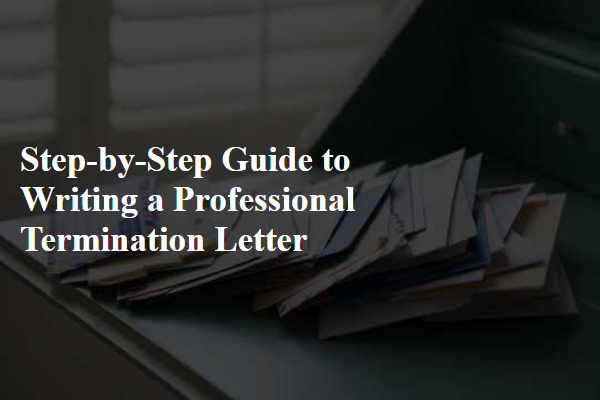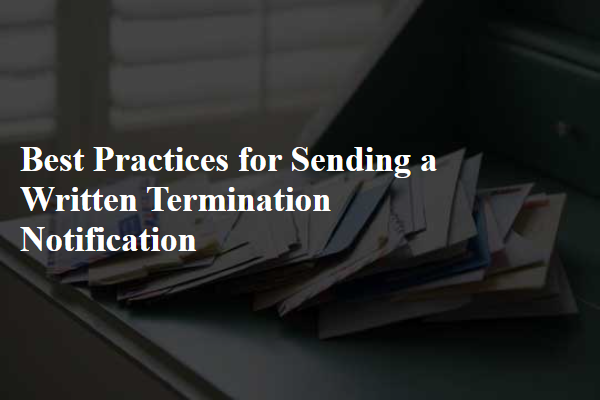
Begin by clearly stating the purpose of the letter and the effective date of termination to ensure transparency. Provide specific reasons for the termination, maintaining a professional and respectful tone throughout the document. Conclude with information on final payments, return of company property, and any available support or resources to aid the transition.
Understanding the Purpose of a Termination Letter
Writing a professional termination letter requires clarity and respect. The letter should clearly state the reason for termination and the effective date.
Start with a formal salutation followed by a concise explanation of the decision. Include any relevant details such as final paycheck information and return of company property.
Reviewing Company Policies and Legal Requirements
```htmlHow do you write a professional termination letter that is clear and respectful? Start by stating the purpose of the letter and the effective termination date. Use concise language to explain the reason for termination without unnecessary details.
What key elements should be included in a termination letter? Include the employee's name, position, and a summary of their performance or behavior leading to termination. Offer information about final pay, benefits, and return of company property.
How can you maintain professionalism and empathy in a termination letter? Use polite and neutral language while acknowledging the employee's contributions. Avoid emotional or accusatory statements to keep the tone respectful.
When is the best time to deliver a termination letter? Present the letter during a private meeting to ensure clarity and allow for respectful communication. Follow up with HR to support the employee through the transition.
What legal considerations should be kept in mind when drafting a termination letter? Ensure compliance with labor laws and company policies to avoid legal risks. Clearly document the reasons for termination and avoid discriminatory language.
```Gathering Relevant Documentation
Writing a professional termination letter requires clear and concise communication. It ensures both parties understand the terms and reasons for ending the employment.
Start by stating the purpose of the letter directly. Include the employee's full name, position, and the termination effective date.
Explain the reason for termination professionally and without emotion. Maintain a respectful tone to avoid potential legal issues.
Outline any next steps, such as final payments, return of company property, or exit interviews. Provide contact information for any follow-up questions.
Choosing the Appropriate Tone and Language
Writing a professional termination letter requires clarity and respect to ensure the message is understood without causing unnecessary conflict. This document serves as an official notice of employment termination and should be carefully crafted.
Begin by stating the reason for termination concisely. Include the official last working day and any relevant details about final payments or benefits. Maintain a respectful tone throughout to preserve professionalism.
Addressing the Recipient Properly
Writing a professional termination letter requires clear communication and respect to ensure a smooth process. This guide outlines the essential steps to create an effective termination letter.
- Start with a clear header - Include the date, recipient's name, and your contact information for formal identification.
- State the purpose directly - Clearly mention the termination of employment and specify the effective date.
- Provide a brief reason - Offer a concise explanation for the termination without unnecessary details.
- Include information about final pay and benefits - Detail any owed salary, severance, or benefits to avoid confusion.
- Express gratitude for service - Maintain professionalism by thanking the employee for their contributions.
- Outline next steps - Mention return of company property, exit interviews, or contact for questions.
- Close with a professional tone - Use a respectful and formal closing statement to conclude the letter.
Following these steps helps ensure a legally compliant and respectful termination letter.
Stating the Reason for Termination Clearly
Writing a professional termination letter requires clarity and respect to maintain a positive relationship between employer and employee. This guide provides essential steps to create a concise and effective termination letter.
- Start with a clear statement - Begin the letter by clearly stating the purpose of termination and the effective date.
- Include reason for termination - Provide a brief, factual explanation for the decision without unnecessary details.
- Outline next steps - Specify any final payments, return of company property, and contact information for questions.
Outlining Final Pay and Benefits Information
Writing a professional termination letter requires clarity, respect, and legal compliance. Begin by clearly stating the termination date and reason, followed by any necessary details regarding final pay or benefits. Conclude the letter with a courteous tone, offering assistance with the transition or next steps.
Including Return of Company Property Instructions
Writing a professional termination letter requires clarity, respect, and legal compliance to ensure a smooth separation process. A well-structured letter protects both the employer and employee by outlining the reasons and terms of termination.
- Prepare Clear Reasons - Define specific and factual reasons for termination to avoid misunderstandings.
- Use a Formal Tone - Maintain professionalism and respect throughout the letter to uphold company reputation.
- Include Important Details - Mention employee information, termination date, and any final compensation or benefits.
- Refer to Company Policy - Cite relevant policies or contracts to ensure legal compliance and transparency.
- Offer Support - Provide information about final paycheck, return of company property, or potential assistance.
- Review and Edit - Proofread the letter to eliminate errors and confirm all details are accurate and complete.
Providing Contact Information for Further Inquiries
Writing a professional termination letter requires clarity, respect, and conciseness. Begin with a clear statement of termination, specify the effective date, and provide a brief reason if appropriate. Include information on final pay, return of company property, and contact details for any questions.
Closing the Letter Respectfully
| Step | Description |
|---|---|
| 1. Review Company Policies | Examine the organization's termination procedures and legal guidelines to ensure compliance and prevent potential disputes. |
| 2. Use Professional Letterhead | Include company logo, name, address, and contact information for formal recognition and authenticity. |
| 3. Include Date and Recipient Details | Clearly state the date of writing and the employee's full name and position to personalize and document the letter. |
| 4. Write a Clear Subject Line | Summarize the letter's purpose, such as "Termination of Employment," to immediately inform the recipient. |
| 5. State the Termination Intent Early | Communicate the decision to terminate employment in the opening paragraph to set clear expectations. |
| 6. Provide Reason for Termination | Specify the grounds for termination, citing performance issues, behavioral concerns, or company restructuring, maintaining factual accuracy. |
| 7. Mention Final Working Day and Next Steps | Indicate the employee's last day at work and any instructions regarding returning company property or final payments. |
| 8. Address Severance and Benefits | Explain severance details, unused vacation payouts, and continuation of benefits if applicable to clarify compensation entitlements. |
| 9. Express Appreciation (Optional) | Include a brief note of thanks for the employee's contributions to maintain professionalism and leave a positive tone. |
| 10. Provide Contact Information | Offer a contact person or HR representative for questions or clarifications regarding the termination process. |
| 11. Sign the Letter | Include the printed name, signature, and job title of the authorized person to validate the letter. |



Comments